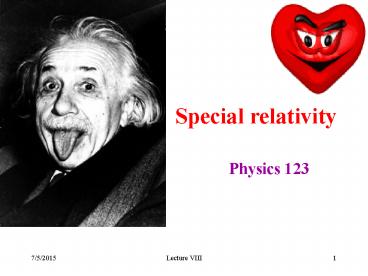Physics 123 - PowerPoint PPT Presentation
Title:
Physics 123
Description:
Special relativity Physics 123 ... – PowerPoint PPT presentation
Number of Views:85
Avg rating:3.0/5.0
Title: Physics 123
1
Special relativity
- Physics 123
2
Outline
- Inertial frames of reference
- Michelson Morley experiment
- Universality of speed of light
- Simultaneity
- 4-dimentional time-space
- Time dilation, twin paradox
- Length contraction
3
Newtonian mechanics
- Newtons 1st law (actually first formulated by
Galileo Galiley) definition of inertial frame of
reference - F0 ? a0 , means no change in speed, no turns
objects continue moving with constant speed in a
straight line
- All laws of physics look the same in any inertial
frame of reference.
4
Inertial frames of reference
- Spaceship is going to Neptune away from Earth
Neptune is going toward ship and Earth is going
away from it.
5
Maxwells theory of Electromagnetism
- Changing electric field creates magnetic field
- Changing magnetic field creates electric field
- Change propagates with a finite velocity
c2.99x108m/c - Electromagnetic wave
6
Combine mechanics and EM
- What do you see when you are riding the wave?
- E is not changing in time does not generate B
- B is not changing in time does not generate E
- This paradox lead scientists to think that
- There is a preferred reference frame (ether)
where physics laws for EM are different
7
Michelson-Morley experiment
- This hypothesis was experimentally tested in 1887
by Albert Abraham Michelson, Edward Williams
Morley Using Michelson interferometer - Measure difference in the speed of light along
the motion of the earth (c v, or c- v) and
perpendicular
8
Michelson-Morley experiment
- Michelson interferometer precision Dl300nm ?
- Dt3x10-7m/3x108m/s10-16s!
- the speed of the earth v3x104m/s
- What base (L) do we need to observe an effect to
the precision limit?
doable!
No difference in c was observed!!!
9
Special relativity theory
- Formulated by Einstein in 1905
- 1st postulate The laws of physics have the same
form in all inertial frames of reference. - 2nd postulate Light propagates through empty
space with a definite speed c independent of the
speed of the source or observer - The speed of light c is the ultimate speed. No
objects (and no information) can travel faster
than c. - Only objects with zero mass can (and always do!)
move at the speed of light
10
Simultaneity
- Einsteins gedanken (thought) experiment
- Observer O1 v
- Lightning strikes at A1A2 and B1B2
simultaneously - In O2s frame of reference O1 first sees light
from B1 then from A1 - In O1s frame of reference O1 first sees light
from B1 and light from A1 simultaneously (light
travels with the same speed in his frame of
reference)
Simultaneity is relative to the frame of reference
11
Space and time are relative to the frame of
reference
12
4-dimensional space time
- Distance between two points A and B
- In one coordinate system X - ABx
- In two coordinate system (X,Y)
- Coordinates depend on the choice of the
coordinate system, but the length does not
rotation invariant
- Add time to space metric
- x1x, x2y, x3z
- x4ict
- 4- dimensional lengthinterval
- Does not depend on the frame of reference
Lorentz invariant - Lorentz transformations rotation in
4-dimentional space-time
13
Lorentz transformations
System (x,yz,t) is moving with respect to
system (x,y,z,t) with velocity v
- Lorentz
- xg(xvt)
- yy
- zz
- tg(tvx/c2)
- Galileo
- xxvt
- yy
- tz
- tt
14
Time dilation
- Clocks moving relative to an observer are
measured by the observer to run more slowly ( as
compared to clocks at rest) - Dt measured in v0 frame, Dt0- measured in
moving frame
Hendrik Antoon Lorentz Derived time and space
transformations before Einstein
15
Twin paradox
- Two twins Joe and Jane. Joe stays on Earth and
Jane goes to Pluto at vltc - Joe observes that Jane's on-board clocks
(including her biological one), which run at
Jane's proper time, run slowly on both outbound
and return leg. He therefore concludes that she
will be younger than he will be when she returns.
- On the outward leg Jane observes Joe's clock to
run slowly, and she observes that it ticks slowly
on the return run. So will Jane conclude that Joe
will have aged less? And if she does, who is
correct?
16
Length contraction
- No change in directions perpendicular to velocity
- The length of an object is measured to be shorter
when it is moving relative to the observer than
when it is at rest
17
(No Transcript)































